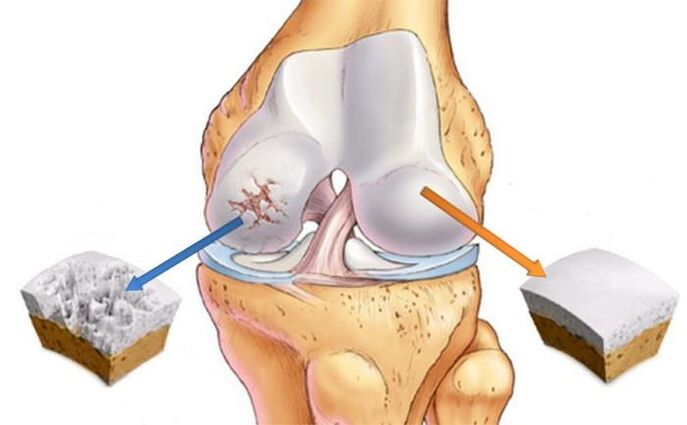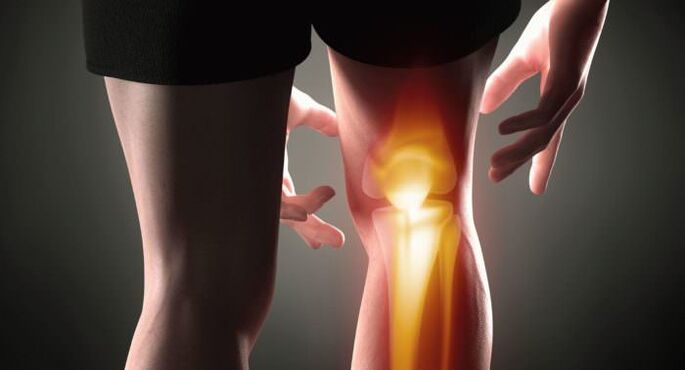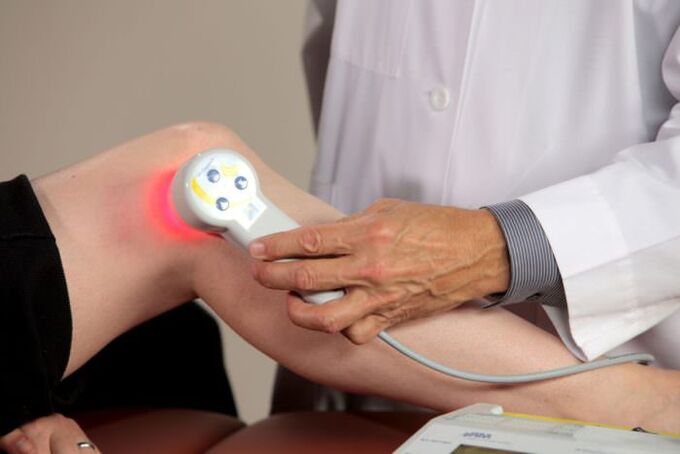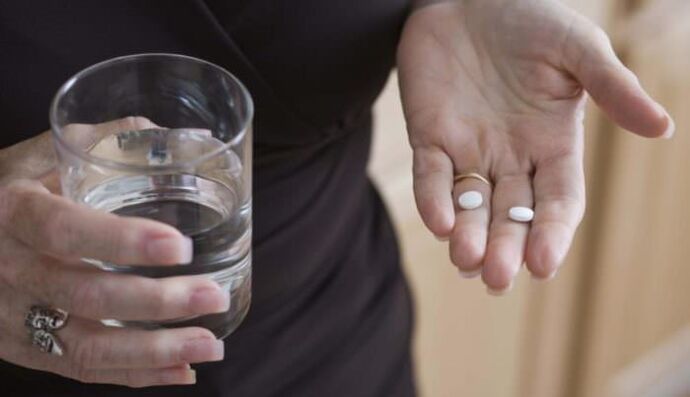Arthritis is not an acute state, but gradually eliminates the gradual nature of impact tissue, and the amount of synovial fluid in the knee joint surface joints decreases. Elastic fabrics provide flexibility and motivation for the limbs, but cartilage sinuses lose this property in the middle and in the elderly.
Interesting! Often, you will hear how middle-aged people talk about "salt deposition". This expression is incorrect, and there is no salt deposition in the body, and on the contrary, the synovial membrane is malnutrition.

Gradually, the depreciation between the femur and the beret decreased, and they began to rub against each other. And, although human bones are very strong and able to withstand direct pressure to 200 kg, they are removed from constant friction, but bone plants appear - bone growth replaces natural joints.
The traumatic form of this disease occurs in young people who prefer strength exercise or car accidents and other serious limb injuries.
If we list the main factors that cause disease development, then the main causes of knee joints can be distinguished:
- Age over forty years old, especially among women.
- Systemic diseases affecting connective tissues - arthritis, lupus red, gout.
- The first type of diabetes.
- Overweight, as this increases chronic load on the limbs.
- Find in forced position sitting or standing.
- Leg trauma status.
In the latter case, the disease usually occurs as a complication of the acute hem, with a large amount of bleeding in the cavity of the knee joint. An upcoming treatment or approach to no medical intervention in emergencies is the reason for the transition to a chronic phase.
Clinical pictures
Signs of knee articity in the early stages usually do not attract attention. Few people pay attention to small deviations from the normative characteristics of the first stage of the disease. Through joints, the symptoms can be seen quickly. Such diseases have emerged:
- Light cuts and postures during exercise are changed drastically;
- Numbness in the lower leg area;
- Fatigue increases at night or long walks.
This is especially true for the middlemen, who write off the situation to age and believe it should be. Indeed, unlike long-term post-traumatic contributions, there is no serious discomfort, and few people consider preventing the disease.
In order to avoid the occurrence of the second degree of symptoms of knee joint joint joint joint joint joint joint joint, this manifestation should not be ignored:
- Swelling;
- Leg fatigue and heaviness;
- If necessary, difficulties will climb up the steep stairs.
However, this symptom is usually not properly paid attention to the disease progression. Clinically important signs appear:

- Pulling or stress pain, exacerbating at night and after awakening.
- Poor limb mobility.
- Swelling does not depend on kidney condition and drunken fluids.
- Gradually increase joint squeaking.
- Can't sit or stand in one position for a long time.
- Sometimes redness occurs around the knees.
This change is a characteristic of chronic adenotropic cancer. In the post-traumatic form, the symptoms grow dramatically and the clinical image of the injury itself develops within a few hours or days. Acute, hard to transition pain is predominant, with obvious swelling of the legs due to damage and congestion in the damaged area is observed, and a person cannot step on the legs. Without post-injury treatment, Atroza usually develops rapidly, and in rare cases, patients face discomfort slow development after 2-7 years.
Important! Despite considerable clinical conditions, the final diagnosis was performed after a complete examination. Diagnostic methods mean ultrasound or X-rays, full-time examinations from rheumatologists or trauma scientists.
On ultrasound and X-ray pictures, internal changes in the synovial shell and the extent of bone growth will be visible. Based on the neglect of the pathological process, the treatment process was specified and a single method was selected.
Types of treatments for those who are accompanying them
Everyone who is diagnosed accordingly must ask a question: How to treat knee joint disease? Medical Providing:
- Conservative treatment with medications;
- Types of treatment that accompany the resort;
- Folk way to combat the disease by demonstrating effectiveness.
Due to the ineffectiveness of the treatment, surgical intervention was pointed out.
drug
If a person is diagnosed with knee articularity, treatment is mainly selected from a range of medications. The traditional list will include various types of medications, starting with painkillers and cartilage protectors.
These ointments are designed to relieve pain and improve the general condition of the patient. Non-replacement analgesics are usually used.
Sometimes, the drug is administered directly into the affected bursal bag. Symptom relief is specified:
- Horizontal type.
- slogan.
- Derived derivatized acid.
Non-surrogate anti-inflammatory and analgesics effectively eliminate unpleasant sensations, and even severe pain, they have obvious side effects and they should be used especially carefully in people with a diseased stomach and liver.
When the process takes place far away and requires serious reactions, hormone medications for third-grade gonadotropitis are prescribed. The cortisol-containing drug is introduced directly into the cartilage cavity and has a very fast positive effect, but the side effects have negative effects on the internal organs (hepatic, heart, blood vessels) and the patient's endocrine background. Therefore, prescriptions are only made in a short period of time without obvious contraindications.

To restore damaged joint tissue, cartilage protectors are used. They are always prescribed for post-traumatic ofthrosis to stimulate the body to be more motivated to produce synovial fluid and regenerate damaged cartilage. Due to slow movement, cartilage protective agents are accepted for a long time. Their reception requires accuracy and systemicity. Considering the specific dose, the age of the patient, the age of the health status, and the characteristics of the health status of certain drugs are considered.
Interesting! The latest method for regeneration of cartilage fluid is hyaluronic acid, which is mainly cosmetic.
Acupuncture in joint pathology
Official medical science has not yet been accepted for a long time. But now, acupuncture occupies a strong position in the treatment of chronic diseases, including any type of pathology in the lower limbs. Acupuncture therapy is properly chosen by experienced experts, which can save people from unpleasant sensations in a short time and stimulate his body to produce sliding fluids and produce cells in the cartilage - regenerating at an accelerated rate.
This technology involves the impact on the biologically active areas and the recovery of the correct function of all living systems, which also helps prevent pain conditions. However, with acupuncture, certain rules must be followed. Acupuncture is prohibited under the following conditions:
- Severe immune changes - immunodeficiency, strong endocrine disease (Cushing's syndrome).
- Trends in tuberculosis and bleeding.
- History of tumor diseases.
- Mental instability, depression, anxiety syndrome.
- Serious injury.
- Any toxicity of Genesis, including chronic alcoholism.
It is recommended to visit the first few times of acupuncture with close relatives or friends, as acupuncture can cause a lot of muscle relaxation and may require help.
Treatment of gymnastics and physical therapy
Joint pathology from any source is well received by physical therapy and exercise therapy. The concept of physical therapy often includes manual, magnets, mud, electrotherapy, and other types of anti-adjuvant adenotropic cancer.
Manual therapy is often used in combination with the LFK complex. Exercises are used to warm up muscles and joints. Purpose of manual method:
- Improve a person's general condition;
- Increased blood flow to sore points;
- Enhance the body's regeneration potential;
- Relieves pain and other symptoms of the disease.
The expert in this treatment should have a good understanding of his work. The correct massage is always directed at lymphatic flow, and any pain or simple discomfort is unacceptable. It is always worth clarifying the composition of the friction and ointment used, as the patient may have an allergy to the separation of active components.
nuance! If the patient studies relevant literature and watches necessary photos and videos, it is likely to learn how to develop friction movements on its own.
Folk therapy
In the early stages of the disease, folk therapy is more reasonable than conservative treatment. Unlike steroids or NSAIDs, they are safe for human health and have been proven to be effective in low and non-resistant conditions, and are also suitable for preventing pathological changes.
Common recipes and influence methods:

- The 5-6 pieces of deposit adhered to the sore point and was previously lubricated with sunflower seed oil. They tied it in a plastic bag and a wool scarf. Compress time at night.
- Birch leaves must be early, and in extreme cases, limb pain will occur in May when they start to morbid early in April. The compression should be less than 3-4 cm. It will also stay overnight.
- Honey massage. Lubricate the preheated legs with thin honey and massage gently for ten to fifteen minutes. Repeat for a month every day.
- Onion soup. Cook the large onions with husks until completely soft. Drink in a glass every day.
- Châlandin. To soak the plants in a bandage (or rag) juice, wrap your legs around for half an hour or an hour. This course lasts for at least one week and is recommended to repeat three times.
Folk methods can be combined with each other and use a variety of recipes at the same time. Basic Rules: They should not be used as alternative therapies, but should be supplemented with medicines from traditional medicine.
Preventive measures for adenotropic cancer
Methods for repairing cartilage changes should be complex and systematic. This means making a complete revision of the lifestyle and following certain suggestions:
- Lose weight. Because overweight has a great negative impact on bones and joint conditions, patients are advised to lose weight.
- Diets in disease should be subject to calorie restrictions, excluding red and fatty meats, fast food, fried foods, sausages, candy and white bread, butter. It is recommended to use olive oil from vegetable fat, only as a salad gas station. Using sea fish and seafood, unsweetened fruits and vegetables are useful. In the power plan, low-fat colds and fruit jelly must be included, preferably without sugar.
- Refusal to smoke and drink – both act on all organs, including connective tissue, and as the smoking experience grows, the bones become thinner, causing the accompanying problem – osteoporosis.
- Dose physical exercise. With the pathology of the limbs, hypoemia and increased activity are contraindicated. People who previously engaged in power and extreme sports will have to give up their hobbies and replace them with people who are less dangerous to their bodies. And, on the contrary, if a person is used to sitting in the office all day, he should organize hiking and jogging, performing gymnastics from exercise therapy. Activities in the swimming pool are very useful.
- It is very important to have regular breaks and accompanying treatments for mineral water in professional resorts.
It is proven that patients can avoid excessive physical exercise, especially weightlifting. For women, oral or injectable hormones are sometimes provided to increase the amount of estrogen in the blood.

Predictive recovery
Can it be cured for knee joint arthritis? It is impossible to completely get rid of the pathology, but it can slow down the degeneration process. It is best to treat the first and second stages after post-traumatic disconnection, while in the third stage, there is a clear pathological process, which usually requires conservative effects and requires surgical intervention.
This operation is performed in the most severe cases, when the joint is completely destroyed, it is replaced by the like of stainless steel or metal plastic. However, by taking timely measures, the prognosis is still favorable, and synovial fluid and connective tissue can be completely regenerated. Observe your health, prevent and correct lifestyle and avoid injuries – the key to leg health and flexibility.
























